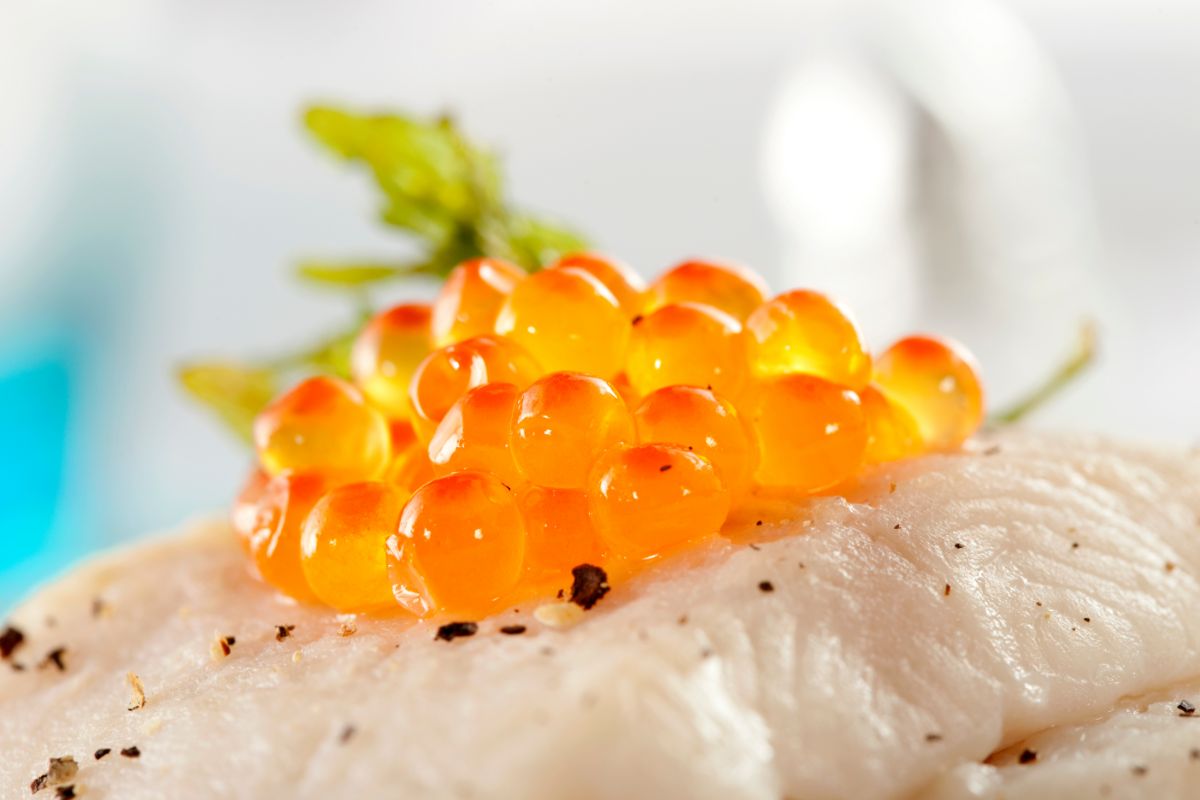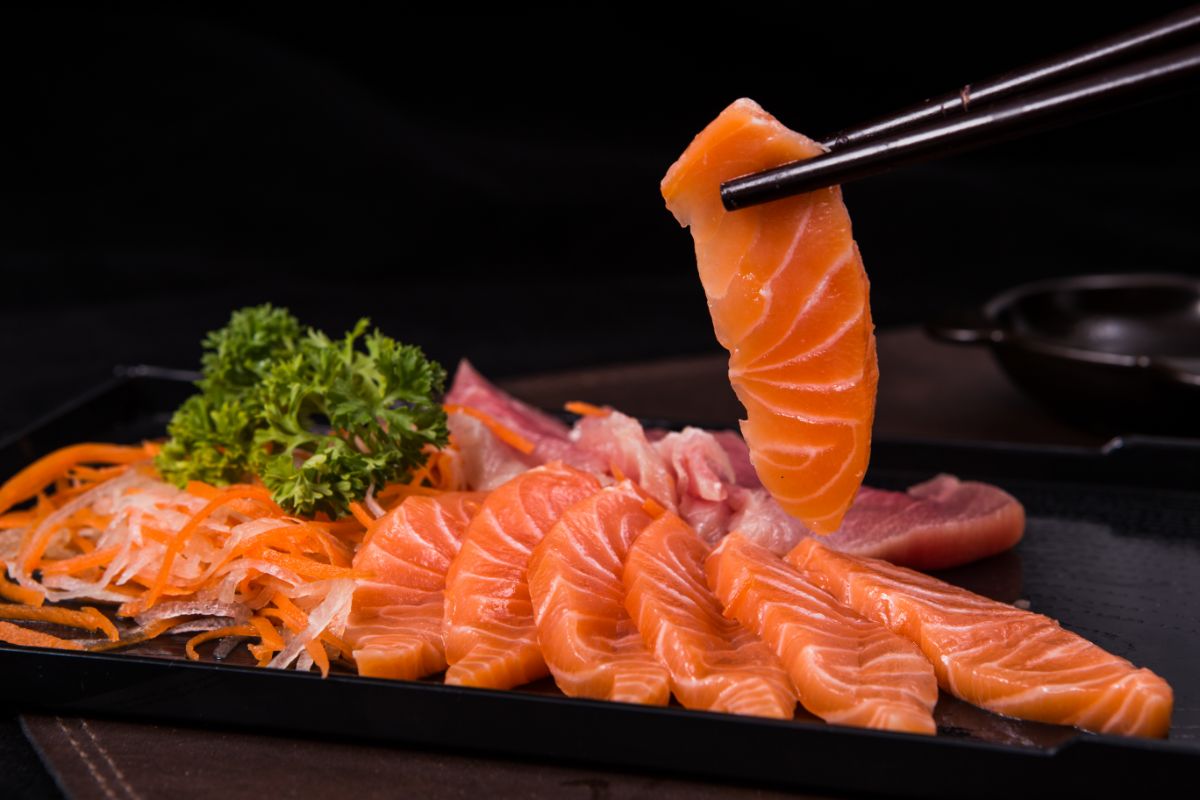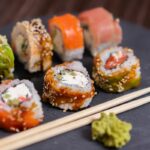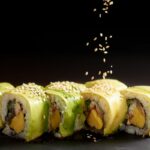Often referred to as a type of red caviar, ikura is salmon roe (also salmon eggs) which is typically served as either a garnish or on its own as an individual dish within Japanese cuisine.
What makes the salmon roe known as ikura is the way it is prepared by the chef. For example, to be considered as ikura, the eggs are removed from the fish and are separately served.
This means the chef has control of how many he or she wants to serve, with this process being referred to as ikura.
If the eggs are kept together as one whole batch, this is then referred to as sukiko.

When kept together, it is soaked up in brine which makes the eggs appear as a red color and slightly sweeter.
The salmon egg tastes very salty, so it can do well as a seasoning which enhances the flavor of a certain dish.
However, having said that, some people find that the salt flavor of the ikura can overpower everything else – and the salty taste isn’t natural either!
Despite the fact that ikura is often referred to as one salmon egg, it is also often referred to as a batch of fish eggs, so in this article we shall be looking at ikura in more detail.
What Is The Taste Like Of Ikura?
Whilst ikura smells terrible (it is fish eggs, afterall), it can also taste quite bland. There is a richness to the salmon egg, despite its lightness and simplicity.
To make it taste better, again, it is fish eggs, it is often marinated in something like soy sauce or salt. This helps to also get rid of the bad smell associated with ikura.
However, the downside to this is that the flavor can sometimes overpower a dish, but it is also used as a seasoning too.
Whilst the ikura is a light thing to eat, once you bite into the egg and the membrane breaks to pop out the egg inside, you might find that it starts to seem a little oily.
Even though that doesn’t sound very nice, ikura is great with dishes.
Can You Eat Ikura Raw?
Speaking of eating ikura, it is mainly served raw. So, if something like sushi isn’t your thing, look away now. Despite the fact that they are more often than not eaten raw, they are never usually served as they are.
Due to their foul smell and simple (but bland) taste, it is commonly marinated in something like soy sauce or salt – anything that will get rid of the smell and make it taste delicious.
Doing so can add flavor to a dish as well, a little bit like adding salt as a seasoning to enhance flavors. As we stated previously, this can either be a good or a bad thing.
Having so much ikura on your plate may add too much seasoning to a dish.
To eat ikura hot is rare, but not unheard of. For example, a local dish of Hokkaido is called ishikari-nabe. It consists of a vegetable stew alongside salmon, butter and miso.
Whilst optional, some people also add ikura to the dish.
Are There Any Health Benefits To Eating Ikura?
There are many health benefits to eating ikura. It is said to include antioxidants, with one being vitamin
A which is helpful for helping to protect the eyes, promotes skin health as well as protects the bone, and can help to achieve a healthy immune system, among so much more.
Another antioxidant that is present in ikura is astaxanthin. It is said to be very potent and can help to fight off damage caused by free radicals. In doing so, it can protect against aging.
Not only does it include powerful antioxidants, but it also has plenty of protein too, making it a great all rounder for body health.
How Can You Eat Ikura?
The most common way to eat ikura is for it to be served in soy sauce to create a sweet yet salty flavor, and for it to be served alongside rice. Here are some examples where you may find Ikura in Japanese dishes:
The Most Common: Sushi
Sushi is a common type of food to eat in Japan, and it consists of eating raw fish. Whilst not to everyone’s taste, it can be delicious, and is usually served with a soy sauce dip for extra flavor.
Ikura can be served with nori filled with rice. It makes for quite a delicate and interesting looking piece of sushi.
Served With Salmon
Salmon eggs and salmon are delicious together, and are usually served as a duo in a bowl along with vegetables.
The Not-So Japanese Pasta Dish
For those who want to try ikura in a familiar dish, then having the salmon eggs scattered on top of a plate of pasta is a great way to experience the flavor. They also go particularly well with mushrooms and other vegetables.
Seafood Don – The Sushi In A Bowl
If you would prefer fish served in a bowl, rather than as sushi – oh, and also cooked – then the seafood don is a great way to experience ikura. However, not everything is cooked in this dish and it tastes very fresh.
Final Thoughts On Ikura
Ikura is a type of raw cuisine in Japan that consists of salmon eggs. It is uncommon to eat as is, and is usually marinated in something like soy sauce to enhance its rather simple flavors – but also to hide the terrible smell.
Whilst it is popular to eat it raw, there are times when people may choose to add it to a hot dish, such as in a Hokkaido local favorite, ishikari-nabe.
There are many ways to add ikura to a dish. In this article we hope you have found out lots of information when it comes to this ‘red caviar’, as well as taken away some ideas to add it to a tasty Japanese dish.
If you enjoyed this post, you might enjoy our article on ‘Does Wasabi Kill Bacteria?‘.
- 16 Best Websites To Watch Japanese Movies With English Subtitles - May 11, 2023
- Is ZIPAIR The Best Airline For Traveling To Japan? - May 11, 2023
- Ryu Murakami Vs Haruki Murakami – Which One Should You Read? - May 11, 2023








